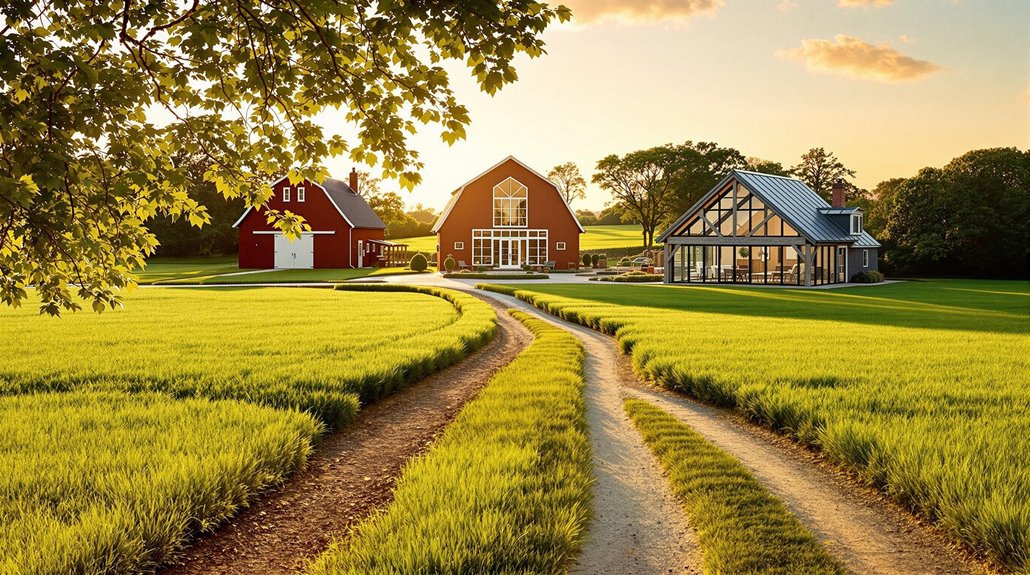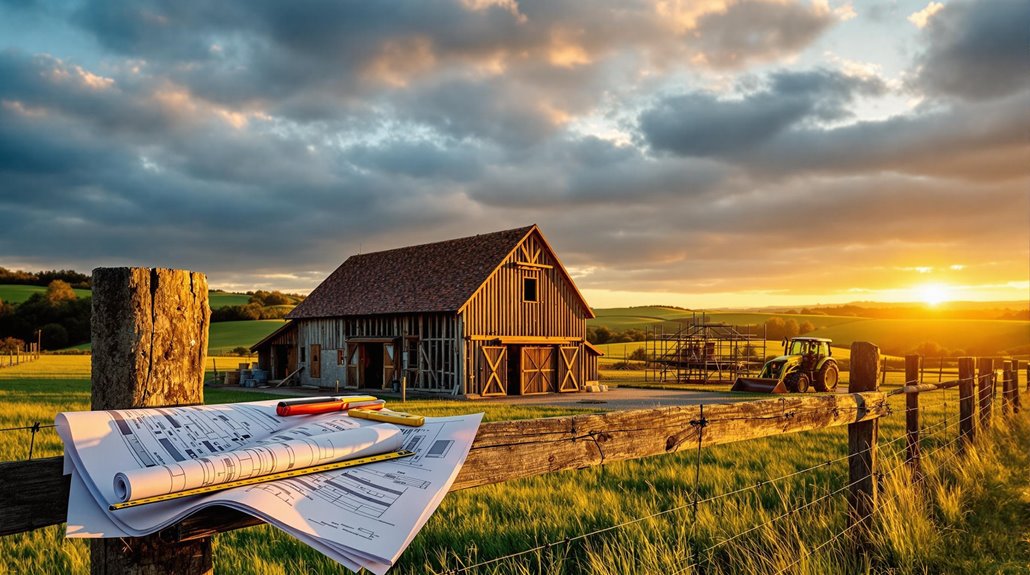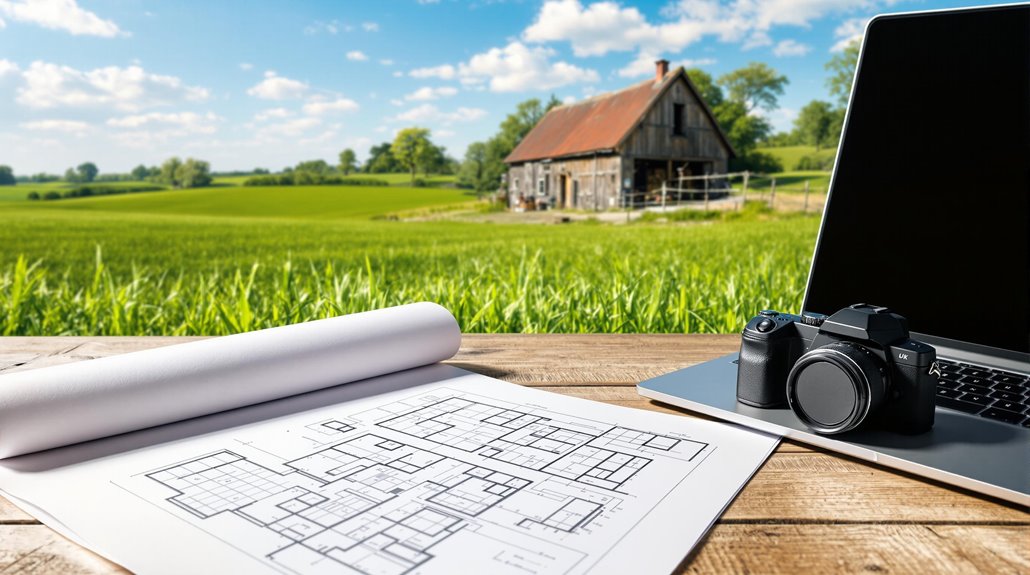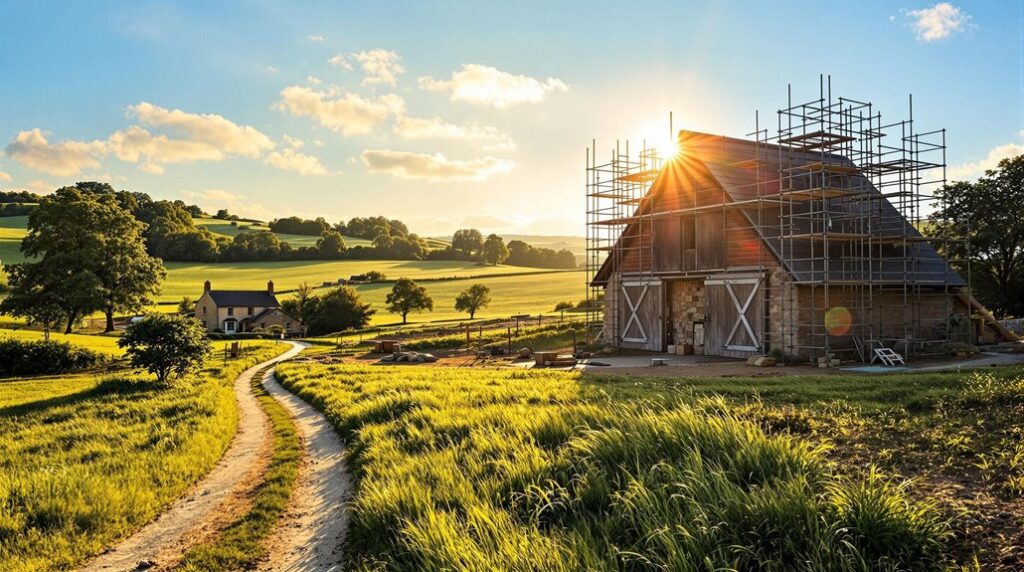I’ll show you exactly how to navigate the barn conversion maze before the critical May 2025 deadline shifts everything. You’ve got two distinct pathways ahead—Class Q’s streamlined route or full planning permission—and choosing wrong could cost you months of delays and thousands in fees. The process isn’t as straightforward as most guides suggest, and there’s a specific sequence of steps that’ll determine whether your rural dream becomes reality or gets stuck in bureaucratic limbo.
Key Takeaways
- Class Q Permitted Development offers the fastest route to convert agricultural barns into residential homes with minimal red tape.
- Critical deadline of May 20, 2025 provides final opportunity for flexible Class Q applications before stricter requirements take effect.
- Convert up to 10 units with maximum 150m² per dwelling, totaling 1,000m² under Class Q permitted development rules.
- Full Planning Permission required for barns in protected areas like AONB, National Parks, or exceeding 465 square meters.
- Buildings must have established agricultural use for 10 years post-March 2013 to qualify for Class Q conversion pathway.
Two Pathways to Transform Your Agricultural Building Into a Home

When you’re ready to convert your barn into a home, you’ll face two distinct planning routes that determine your project’s scope, timeline, and approval odds.
Class Q Permitted Development offers the fastest path if your barn meets specific criteria. Your building must’ve been solely agricultural for 10 years (if built after March 2013), and you’ll need to retain the original structural framework. This route has fixed floorspace limits and stricter requirements since May 2025.
Full Planning Application becomes necessary when your barn fails Class Q criteria or your vision exceeds permitted development limits. You’ll submit detailed plans to your local council, including heritage statements and impact assessments. While there’s no fixed floorspace cap, your proposal must align with local planning policies and demonstrate how you’ll preserve rural character. You can now convert buildings that were unused since 24 July 2023, expanding eligibility beyond previously stricter timeframes.
Class Q Permitted Development: Your Fast-Track Route to Conversion
If your barn meets the right criteria, Class Q Permitted Development cuts through red tape and delivers the fastest route to residential conversion. I’ll show you exactly how this works.
You’ll sidestep the full planning application process, slash your costs, and accelerate your timeline considerably. Here’s what makes you eligible: your building must’ve been agricultural by July 24, 2024, be structurally sound, and have highway access. Additionally, undertaking a conversion can significantly increase your property value and enhance your living space.
You can convert up to 10 units with 150m² maximum per dwelling, totaling 1,000m². You’ll need a structural survey, design plans maintaining rural character, and proof of agricultural use. The barn must also be structurally capable of functioning as a dwelling with adequate natural light in all habitable rooms.
Here’s your critical deadline: submit before May 20, 2025. After that, only smaller conversions qualify under Class Q. Larger projects will require full planning permission, costing you time and money.
Beat the Clock: Critical May 2025 Deadline Changes Everything

May 20, 2025 represents your final opportunity to submit Class Q applications under the current flexible rules. I’ll walk you through what’s changing and why you need to act now.
After this deadline, you’ll face stricter requirements: maximum 150m² per dwelling unit, mandatory Established Agricultural Unit status by July 24, 2023, and three-year completion deadlines instead of commencement timelines. However, if you already have previous approvals, they remain valid if completed within 3 years of the original approval date. Additionally, it’s crucial to be aware of planning permission regulations that may impact your project.
Here’s your action plan: First, gather evidence proving your barn’s EAU status with land agreements and historical records. Second, prepare your Design and Access Statement documenting pre-July 2023 qualification. Third, submit before May 20th to secure unlimited dwelling sizes and flexible conversion standards.
Don’t let bureaucratic changes derail your rural dream. Join the community of successful converters who seized this changeover opportunity.
When Class Q Won’t Work: Navigating Full Planning Permission
While Class Q offers the fastest route to barn conversion, certain circumstances force you down the full planning permission path—and that’s not necessarily bad news.
You’ll need full planning permission when your barn sits in an AONB, National Park, or Green Belt area. If your building exceeds 465 square meters, requires major structural redesign, or lacks ten years of continuous agricultural use, Class Q won’t apply.
Here’s your action plan: First, commission a structural survey to document existing conditions. Next, engage a planning consultant familiar with your local authority’s policies. Then, prepare detailed drawings showing proposed alterations within the original footprint where possible. Understanding planning permission requirements can help streamline your application process.
Full planning permission actually offers more flexibility—you can modify external appearances, add extensions, and create unique designs that Class Q restrictions would prohibit. A pre-application consultation is recommended to assess feasibility before submitting your full application.
Essential Steps to Submit Your Application and Secure Approval

Once you’ve determined your application route, success hinges on meticulous preparation and strategic submission timing. I’ll guide you through the essential steps that separate successful applicants from those facing rejection.
First, compile your documentation arsenal: structural reports proving building integrity, contamination assessments for agricultural sites, and scaled architectural drawings with elevations and floor plans. Don’t forget flood-risk evaluations if you’re in designated zones. Utilizing a tool like an Extension Cost Calculator can also help you budget effectively for potential costs associated with your project.
Next, tackle the submission logistics. Pay your council fees and file through the Planning Portal or your local authority’s system. You’ll need to respond to queries within 21-day consultation windows, so stay vigilant. Remember that substantial rebuilding may result in your proposal being classified as a new build rather than a conversion, which faces stricter approval criteria under rural development policies.
For Class Q applications, you’ve got 56 days for determination. If refused, you can appeal through the Planning Inspectorate with solid evidence backing your case.
Conclusion
I’ve walked you through both conversion pathways—Class Q’s streamlined process and full planning permission for complex projects. You’ve got the essential steps, critical deadlines, and practical tools needed to succeed. Don’t let May 2025’s deadline slip away. Start your application now, gather your documentation, and take action. Your rural dream home‘s within reach if you follow these proven strategies and submit before time runs out.
References
- https://nortontaylornunn.co.uk/barn-conversion-deadline-for-major-rule-changes/
- https://urbanistarchitecture.co.uk/barn-conversion/
- https://hudsonarchitects.co.uk/journal/architectural-insights/achieving-planning-permission-for-your-barn-conversion/
- https://berrys.uk.com/news/class-q-transition-period-comes-to-an-end/
- https://resi.co.uk/advice/house-extensions/barn-conversions-guide
- https://www.planninggeek.co.uk/gpdo/changes-of-use/class-q/
- https://clarenasharchitecture.co.uk/important-changes-to-class-q-permitted-development-may-2025-update/
- https://hardcastlerural.co.uk/planning-&-design/f/class-q-deadline
- https://defrafarming.blog.gov.uk/2024/05/10/changes-to-permitted-development-rights/
- https://www.clwydianplanning.co.uk/blogs/barn-conversions-a-guide

